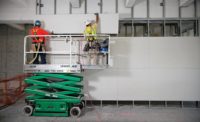Insulated Metal Panels Do the Job Right
Sustainability, Durability, Aesthetics—IMPs Have It All For Walls.

If you are in the construction or design community, the word sustainability likely comes up frequently in your daily life. The growing debates and discussions on Climate Change and its effect on our future is a constant and relevant topic these days. I would also say that few people you meet don’t want to do right by our environment and ensure that we are all good stewards of the earth. It’s not the end goal; it’s the method that has elicited most of the debate. But much like a diet, we know what’s good for us but we sometimes have a hard time sticking to the plan or knowing which one is best.
Like many of my contemporaries, my introduction to sustainability was courtesy of a booming voice from my father asking if “I lived in a barn” as he demanded I shut the door behind me as I would come into our family home. Conservation of energy was clearly on his mind, and keeping a watchful eye on doors and windows and turning off lights in empty rooms was a constant reminder to not waste our resources because they cost money.
These early lessons led to the energy crisis generation looking for ways to reduce consumption and improve efficiencies. It also led to groups like the USGBC and Energy Star, and a host of others, along with an ever-growing influence on recycling and clean air legislation.

Progress Has Been Made
While we can always do better, there has been tremendous progress on the clean energy and clean air fronts in the last 40 years. We sometimes have to be reminded of that.
Today, the renewed emphasis on EVs is the latest strategy to address our consumption. How ironic that EVs have been around for over 100 years and might have been more popular had it not been for the phenomenal efficiency of the combustion engine and the abundance of fossil fuels. For those of us in the construction industry, our contribution to this effort is to focus on energy consumption. It is often cited that buildings consume 1/3 of the energy in the U.S. and emit significant CO² to operate. You’ve undoubtedly seen infrared photos demonstrating the waste generated in the average building.


Our Neck of the Woods
It would be easy to assume that IMPs are a new technology in the U.S. as it is less widespread a building product than in Europe, where it is well established and accepted. The country will eventually catch on in a big way. For more than 50 years in the U.S., it has been a product of choice for the cold storage world as it is a very effective method to deliver insulation to projects where temperature control is paramount. The design of a closed cell foam core surrounded by a sheet of metal on the inside and outside, has proven to be a great way to get the very high R-values this industry requires. Improvements in manufacturing have made IMPs more available at a more affordable cost.
Because the cold storage industry requires that air and water vapor be addressed, the tongue and groove designs used in IMPs have effectively maintained temperatures, which may account for their popularity in this market. And because it is a finished wall, it can increase the speed of construction, which can help reduce construction costs and get a facility up and running on schedule, which has been an issue during the labor shortages of the last few years. It is lightweight, made of recyclable materials, and durable and long lasting.
Most designs utilize a hidden clip for attachment located within the tongue and groove that provides for the thermal break to maintain continuous insulation, which is touted increasingly as a goal for all buildings. It is easy to see that IMPs check the many boxes that a sustainable design would require.
You are increasingly seeing the panels used as the base barrier wall where hats or girts are attached to the exterior surface. In that way, architects have added aesthetic features such as rainscreens and other attachments, like perforated panels and even blades or wings, to reach their design goals. IMPs can meet many of the aesthetic desires the design community is looking for, but can also offer the insulation values that make it a sustainable choice. In our battle against climate change, these panels can meet the challenge.
A growing retrofit industry has blossomed to address this issue. So, the low-hanging fruit in the pursuit of sustainability is to look at reducing the energy escaping from our buildings and reducing the energy required to heat and cool. This is the message that we, as an industry, must continue to get out there. It can be argued that reducing consumption may be a better strategy than simply redirecting the fuel source as with EVs, where energy still needs to be produced to operate the vehicles. So, while NetZero is a term utilized in construction, it is not used in EVs. Energy saved is energy not used. So, it is clear that the construction industry is well positioned to lead the efforts to reduce emissions and build a greener society.
With that said, there are a host of products and systems that have been designed and manufactured to do just that: lower the impact of energy usage. To reduce the use and waste of energy, we have to look at insulation. There are many ways to address that and there are undoubtedly many products; one of which are insulated metal panels and how they meet the criteria to be an effective material to fight climate change.
Looking for a reprint of this article?
From high-res PDFs to custom plaques, order your copy today!









